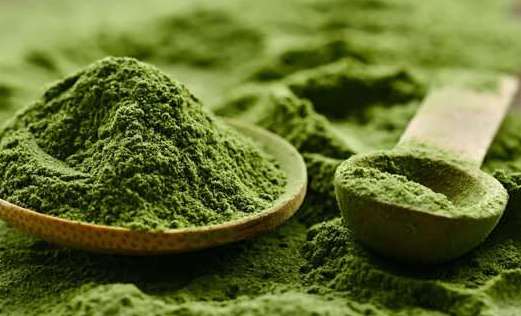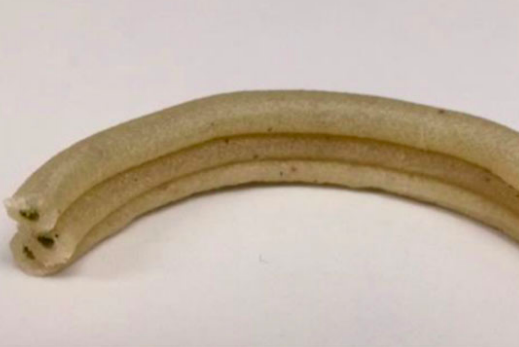Researchers from the Dutch University of Wageningen and Spanish University of Valencia, have 3D printed a selection of micro-algae-based cereal snacks.
Using a dual-extrusion 3D printing process, the team attempted to make their foods tastier and more visually appealing by customizing their shape, texture and color. Although the scientists needed to add green algae to their edibles to lend them integrity, they believe that in future, a coaxial printing approach could allow their color to be “hidden” deep inside the healthy treats.

The health benefits of indulging in algae
Microalgae, and in particular the Chlorella and Arthrospira variants of the sea-dwelling plant, are especially healthy for the human body, making them promising ingredients for potential snacks. Both species are freshwater, and produce proteins, minerals, vitamins, pigments, fatty acids, sterols and antioxidants, that would nicely compliment a well-balanced diet.
The health benefits of algae haven’t escaped the attention of shoppers either, and numerous plant-infused biscuits, breads and other baked goods have been marketed in recent years. In spite of their nutritional value though, the foods’ color has proved to be a turn-off for would-be adopters, as baked provisions aren’t traditionally green in appearance.
3D printing-based approaches offer a potential solution to this problem, as they allow foods to be customized in order to meet individual needs. Food production firm Redefine Meat for instance, has fabricated a vegan-friendly steak, while student start-up Legendary Vish has developed a range of healthier fish-focused food products.
Scientists from the Singapore University of Technology and Design have even found a way of 3D printing with milk, reflecting the advances that have been made in extrusion-based food printing processes. In the more recent Spanish-Dutch collaboration, the team proposed that microalgae could be used in a similar way, to print snacks that were more structurally similar to their sweeter counterparts.

Rustling up a 3D printed snack
To test their theory, the researchers formulated two different types of batter, in which they replaced the wheat flour conventionally used to bake bread, with varying concentrations of freeze-dried algae. These green structures were then dual extruded through the nozzle of a Byflow 3D printer, with one printhead depositing the algae mix, and the other printing a control batter.
The foodstuff was extruded into a cylinder measuring 50 mm x 3 mm, to provide shape to the algae-based foods, before they were baked into their final form. Once they had fabricated and cooked their cylindrical snacks, the team performed a series of tests on them, to evaluate and optimize their printing behavior.
Statistical analysis of the batters’ physicochemical properties, showed that the addition of microalgae reduced its water absorption capacity, as it competed with other ingredients for moisture. Interestingly, Spirulina algae was also found to yield considerably greener foods than Chlorella, indicating that the latter could represent a more appealing basis for future snacks.

Further rheological evaluation revealed that the batters enriched with microalgae exhibited a higher viscosity during processing, and ultimately required a higher shear stress to print. The team managed to fortify their cereal snacks using another green ingredient, spirulina, but this had the predictable effect of making them even greener than they had been before.
In an attempt to print batters that were a little bit less green, the team conducted a final experiment in which they used coaxial extrusion to produce cylinder-shaped samples instead. Within the last version of the snack, its green color had been transformed into a more traditional light brown, potentially laying the groundwork for the creation of tastier looking treats.
Following their additive bake-off, the researchers concluded that they had successfully created foods with a very high level of nutritional value. In terms of making the snacks more appealing though, the team suggested that using a coaxial extrusion method, it may be possible to print tastier and more conventional-looking treats in future.
The researchers’ findings are detailed in their paper titled “Printability and Physicochemical Properties of Microalgae-Enriched 3D-Printed Snacks.” The study was co-authored by Zaida Natalia Uribe-Wandurraga, Lu Zhang, Martijn W. J. Noort, Maarten A. I. Schutyser, Purificación García-Segovia and Javier Martínez-Monzó.
To stay up to date with the latest 3D printing news, don’t forget to subscribe to the 3D Printing Industry newsletter or follow us on Twitter or liking our page on Facebook.
Looking for a new podcast? Be sure to subscribe to the Another Dimension podcast on your chosen podcast player to make sure you never miss an episode.
Are you looking for a job in the additive manufacturing industry? Visit 3D Printing Jobs for a selection of roles in the industry.
Featured image shows a bowl full of microalgae-based powder. Photo via phys.org



